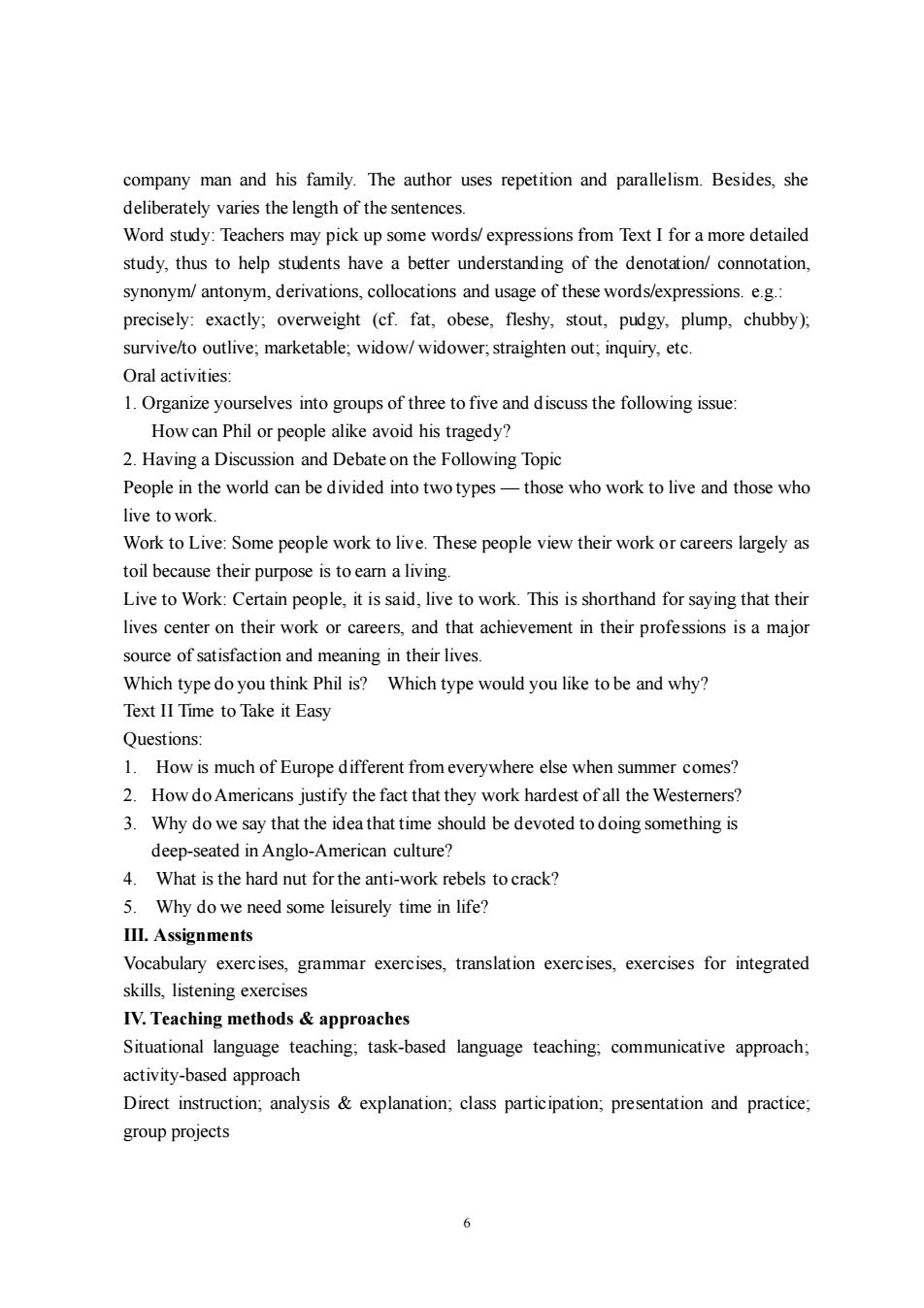正在加载图片...

company man and his family.The author uses repetition and parallelism.Besides,she deliberately varies the length of the sentences. Word study:Teachers may pick up some words/expressions from Text I for a more detailed study,thus to help students have a better understanding of the denotation/connotation. synonym/antonym,derivations,collocations and usage of these words/expressions.e.g.: precisely:exactly;overweight (cf.fat,obese,fleshy,stout,pudgy,plump,chubby). survive/to outlive;marketable;widow/widower,straighten out;inquiry.etc. Oral activities: 1.Organize yourselves into groups of three to five and discuss the following issue How can Phil or people alike avoid his tragedy? 2.Having a Discussion and Debateon the Following Topic People in the world can be divided into two types-those who work to live and those who live to work. Work to Live:Some people work to live.These people view their work or careers largely as toil because their purpose is toeam a living. Live to Work:Certain people,it is said,live to work.This is shorthand for saying that their lives center on their work or careers,and that achievement in their professions is a majo source of satisfaction and meaning in their lives. Which typedo you think Phil is?Which type would you like to be and why? Text II Time to Take it Easy Questions 1.How is much of Europe different fromeverywhere else when summer comes? 2.How doAmericans justify the fact that they work hardest ofall the Westemers? 3.Why do we say that the idea that time should be devoted to doing something is deep-seated in Anglo-American culture? 4.What is the hard nut for the anti-work rebels to crack? 5.Why do we need some leisurely time in life? III.Assignments Vocabulary exercises,grammar exercises,translation exercises,exercises for integrated skills,listening exercises TV.Teaching methods approaches Situational language teaching task-based language teaching communicative approach. activity-based approach Direct instruction;analysis explanation:class participation;presentation and practice group projects 66 company man and his family. The author uses repetition and parallelism. Besides, she deliberately varies the length of the sentences. Word study: Teachers may pick up some words/ expressions from Text I for a more detailed study, thus to help students have a better understanding of the denotation/ connotation, synonym/ antonym, derivations, collocations and usage of these words/expressions. e.g.: precisely: exactly; overweight (cf. fat, obese, fleshy, stout, pudgy, plump, chubby); survive/to outlive; marketable; widow/ widower; straighten out; inquiry, etc. Oral activities: 1. Organize yourselves into groups of three to five and discuss the following issue: How can Phil or people alike avoid his tragedy? 2. Having a Discussion and Debate on the Following Topic People in the world can be divided into two types — those who work to live and those who live to work. Work to Live: Some people work to live. These people view their work or careers largely as toil because their purpose is to earn a living. Live to Work: Certain people, it is said, live to work. This is shorthand for saying that their lives center on their work or careers, and that achievement in their professions is a major source of satisfaction and meaning in their lives. Which type do you think Phil is? Which type would you like to be and why? Text II Time to Take it Easy Questions: 1. How is much of Europe different from everywhere else when summer comes? 2. How do Americans justify the fact that they work hardest of all the Westerners? 3. Why do we say that the idea that time should be devoted to doing something is deep-seated in Anglo-American culture? 4. What is the hard nut for the anti-work rebels to crack? 5. Why do we need some leisurely time in life? III. Assignments Vocabulary exercises, grammar exercises, translation exercises, exercises for integrated skills, listening exercises IV. Teaching methods & approaches Situational language teaching; task-based language teaching; communicative approach; activity-based approach Direct instruction; analysis & explanation; class participation; presentation and practice; group projects